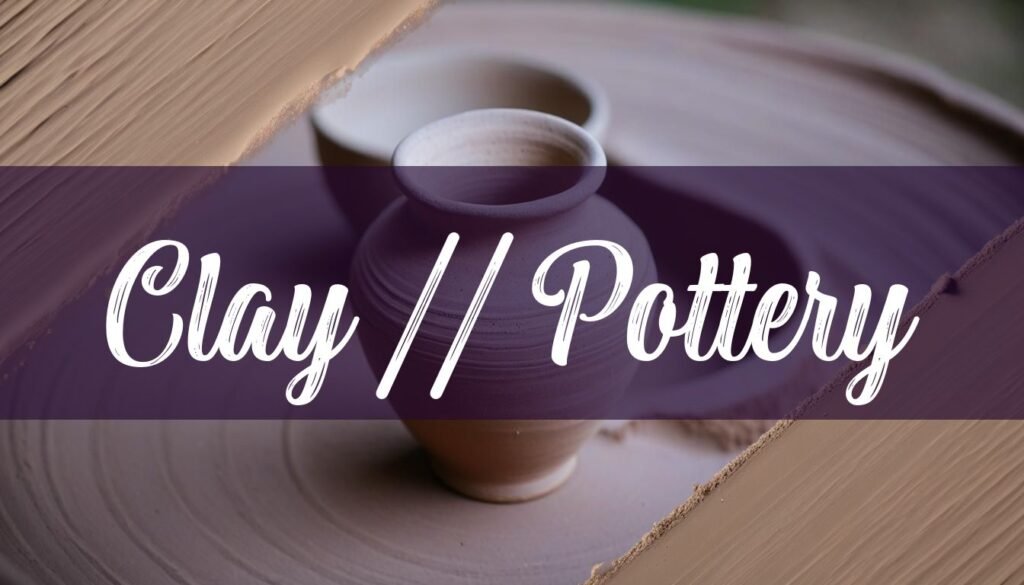Choosing the right clay for pottery is a foundational step in bringing your creative visions to life. Like selecting the perfect canvas for a painting or the ideal wood for a sculpture, the type of clay you choose significantly influences the final outcome of your ceramic art. Different clays possess unique properties that make them suitable for various techniques, firing temperatures, and desired aesthetics. Understanding these properties is essential for both beginners and experienced potters alike, ensuring successful and satisfying pottery making. There are 6 main types of clay, but this article will focus on the three major categories of pottery clay: earthenware, stoneware, and porcelain, while detailing their characteristics such as firing temperature, shrinkage, water absorption, and plasticity. (Kilnfire.com)
Each type of clay offers a distinct set of characteristics that cater to different pottery needs. These characteristics include plasticity, firing temperature, porosity and more. Plasticity refers to the clay’s malleability and ease of shaping, (Kilnfire.com) which determines how well the clay can be molded and formed without cracking or breaking. Firing temperature is the range of kiln temperatures at which the clay vitrifies or sinters to become ceramic. (Kilnfire.com) Different clays mature at different temperatures, and it’s crucial to match the clay to your kiln’s capabilities. You can find information on firing options here. Porosity indicates the clay’s ability to absorb water after firing. (Kilnfire.com) Earthenware, for example, is more porous than stoneware or porcelain, affecting its suitability for certain applications. Shrinkage refers to the degree of reduction from the initial wet size to the finished fired piece. (Kilnfire.com) Clays shrink as they dry and fire, and understanding the shrinkage rate is important to avoid cracking and warping. With a grasp on these key properties, you can navigate the world of clay with greater confidence.
Exploring Earthenware, Stoneware, and Porcelain
Earthenware is often the first clay encountered by beginner potters, prized for its ease of use and vibrant color potential. (SoulCeramics.com) Known for its high plasticity, earthenware is easy to manipulate and work with, making it forgiving for those still developing their skills. Earthenware clay generally matures at a firing temperature of about 950°C and 1,100°C (or 1,745°F and 2,012°F). (SoulCeramics.com) This lower firing temperature makes it accessible for potters using a variety of kilns. However, earthenware is porous when fired at high temperatures (SoulCeramics.com), meaning it’s best suited for decorative items or pots intended for growth, unless glazed to make it impervious to liquids (Seattle Pottery Supply). Earthenware has high absorbency and shrinkage rates. (Kilnfire.com) Basic earthenware, often called terracotta, absorbs liquids such as water. (Seattle Pottery Supply) One of earthenware’s charms is its ability to take on rich, warm colors when fired, thanks to its composition of iron and other mineral impurities. (SoulCeramics.com) This makes it a versatile choice for sculpting, hand-building, and wheel throwing. (Seattle Pottery Supply)
Stoneware stands as a robust and versatile option, favored for its durability and suitability for functional pottery. Stoneware clays contain mineral impurities such as silica, feldspar, ball clay, and quartz. (SoulCeramics.com) Typically, the firing range of stoneware clay is much higher than that of earthenware clay (stoneware is fired at a temperature range between 1000°C and 1380°C). (SoulCeramics.com) Stoneware refers to any clay that is fired at this temperature and also that it turns stone-like and durable when fired. (SoulCeramics.com) The increased heat makes stoneware less porous and absorbent than earthenware. (Kilnfire.com) This makes stoneware clay a popular clay to use for tableware. (Seattle Pottery Supply) Unlike porcelain, which is almost always white, stoneware is usually colored gray or brownish because of impurities in the clay; potters can make stoneware with multiple different clay colors today. (Seattle Pottery Supply) Stoneware has better structural strength and resists thermal shock. (Kilnfire.com) It is also sometimes mixed with ball clay and fire clay to increase its resistance to heat and make harder, more resilient pieces. (SoulCeramics.com) It is suitable for a variety of glazes (Diamond Core Tools) and its high plasticity, which aids shaping, combined with low shrinkage, which resists cracking (Kilnfire.com), make stoneware a versatile studio clay.
Porcelain represents the pinnacle of ceramic artistry, celebrated for its delicate beauty and luminous translucence. Porcelain clay is sometimes known as kaolin as this is what it is made of. (SoulCeramics.com) It is almost purely made up of kaolin clay, with occassional amounts of quartz and feldspar when manufactured. (SoulCeramics.com) Porcelain creates delicate, translucent pieces with a polished finish. (Diamond Core Tools) Porcelain clays fire at the highest range from 2200-2600°F. (Kilnfire.com) It becomes incredibly dense and non-porbose at these temperatures. (Kilnfire.com) Porcelain is white in color when pure. (Kilnfire.com) The structure of this clay allows it to withstand the high temperatures in a kiln and when fired it becomes non-porous and very hard. (SoulCeramics.com) It’s more difficult to work with than stoneware or earthenware. (Kilnfire.com) Once you master this clay type, it is best used to create serving ware and other functional cooking or drinking pottery pieces to increase the overall value and professionalism of the piece. You can even use it to create ceramic jewelry. (Diamond Core Tools)
Making the Right Choice
Selecting the right clay involves considering your skill level, available equipment, and artistic goals. For beginners, earthenware’s forgiving nature and lower firing temperatures make it an ideal starting point. (Seattle Pottery Supply) As you gain experience, stoneware offers a versatile option for functional pieces, providing durability and a wide range of glazing possibilities. (Diamond Core Tools) Porcelain, with its demanding nature, is best approached once you have a solid foundation in pottery techniques, allowing you to create refined and elegant works. Check out these advanced pottery throwing techniques once you’re ready. (Diamond Core Tools)
Ultimately, the best clay is one that aligns with your artistic vision and practical considerations. Experimentation is key, as each clay responds differently to various techniques and glazes. Embrace the learning process, and don’t be afraid to explore the full spectrum of clays available to discover your personal favorites. With the right clay in hand, you’ll be well-equipped to embark on a fulfilling journey of ceramic creation.





